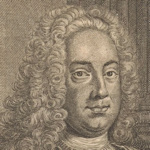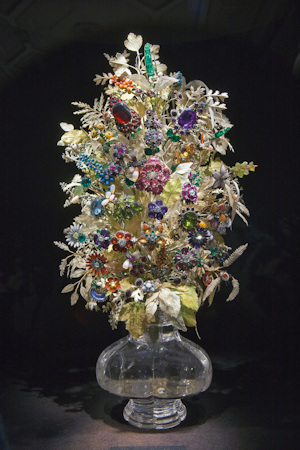
With all the art museums in Vienna, it’s strange to find one of the city’s most extraordinary pieces of art and design in the Natural History Museum: Maria Theresa’s 18th-century gemstone bouquet.
- A gift from the Empress to her husband, Emperor Franz Stephan from 1764
- Contains over 2800 (!) diamonds and other gemstones
- See also:
Diamonds are a man’s best friend

(Emperor Franz I. Stephan von Lothringen, recipient of a rather fabulous bouquet; painted by Martin van Meytens around 1740; Wien Museum Inv.-Nr. 61012; excerpt reproduced under the terms of the CC BY 4.0 license; photo by Birgit and Peter Kainz, Wien Museum)
Cast your mind back to 1764. Empress Maria Theresa drums her fingers on an (expensive) table and thinks about what to get her husband, Franz Stephan, for his name day1. Or so the story goes.
A nice tie from Bohemia, perhaps?
A pair of socks from Galicia?
A bouquet of flowers from the palace garden?
Or perhaps a mug with World’s Best Holy Roman Emperor on it?
Fortunately for Maria Theresa, Franz had plenty of interests outside of his court obligations. These included mining and minerals. In fact, his interest in geology and the natural world led to the great collections that form the basis for the Natural History Museum.

(The gemstone bouquet. Photo courtesy of and © Naturhistorisches Museum Wien)
So what better than to combine Franz’s interests with a suitable gift? Which is where the Edelsteinstrauß (gemstone bouquet) comes in: a bunch of flowers with a not-so-subtle difference.
One might argue that Maria Theresa spent a little more than required with this present. For starters, the bouquet’s vase is pure quartz.
The leaves? Silk.
And the flowers? Gemstones.
At 50cm high, that means a lot of gemstones. More than you might imagine. According to the museum, the total is 2,102 diamonds and 761 precious and ornamental stones.
The court jeweler, Johann Michael Grosser, completed the bouquet, though it seems likely that Johann Gottfried Lautensack in Frankfurt did the preliminary work. Visit the Imperial Treasury to see another of Grosser’s masterpieces: the 1757 cross of the Military Order of Maria Theresa.
The true beauty of Maria Theresa’s gift lies in the detail.
The flowers take different forms and colours, for example, as if picked from a meadow or country garden. And any realistic representation of a Baroque bouquet needs to have insects, too…also made of gemstones.
So you have, for example, diamond-encrusted antennae poking above the leaves, flies with wings of what looks like onyx, and a sapphire caterpillar (which might just be the colour or, literally, a sapphire).
As you look closer at the bouquet, more and more details emerge. You can barely begin to imagine the work that must have gone into it.
Which leaves just one question: how do you top that when your husband’s birthday comes around?
How to get to the gemstone bouquet
Follow the tips for reaching the Natural History Museum. Once inside, take the stairs to the right up to the geology galleries.
The gemstone bouquet normally sits within a glass display cabinet in Saal IV (Gallery 4), embedded in the wall shared with Saal V.
That gallery houses plenty of other valuable artifacts. Neighbouring cabinets contain some quite astonishing examples of gemstones and precious metals, from an 82.2 carat diamond to an 826g nugget of gold.
Carry on through the museum to find another highlight of Vienna’s collection of valuable art and historical artefacts. The prehistory section has one of the world’s oldest Venus figurines: the Venus of Willendorf felt the touch of the craftsperson over 29,000 years ago.
Address: Burgring 7, 1010 Vienna
1The name day is the poor cousin to a birthday; it celebrates the day of the year associated with your first name, usually through some connection to a saint.